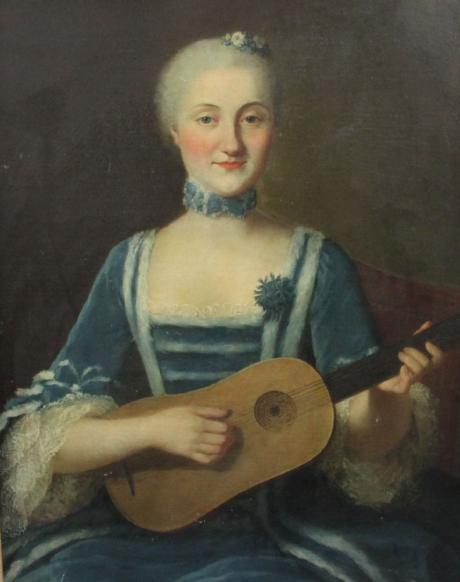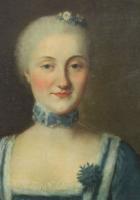The Baroque 6 string Guitar is mostly likely to be French and representing the period 1780-1790's. By 1800 it became widespread and popular. Maurice Quentin de La Tour (5 September 1704 – 17 February 1788) was a French Rococo portraitist who worked primarily with pastels. Among his most famous subjects were Voltaire, Rousseau, Louis XV and Madame de Pompadour. He was born in Saint-Quentin, Aisne, the son of a musician who disapproved of his taking up painting. At the age of fifteen La Tour went to Paris, where he entered the studio of the Flemish painter Jacques Spoede. He then went to Rheims in 1724 and to England in 1725, returning to Paris to resume his studies around 1727. After his return to Paris, he began working with pastels.In 1737 La Tour exhibited the first of a splendid series of 150 portraits that served as one of the glories of the Paris Salon for the next 37 years. Endowing his sitters with a distinctive charm and intelligence, he excelled at capturing the delicate play of their features. In 1746 La Tour was received into the Académie de peinture et de sculpture and in 1751 was promoted to councillor. He was made portraitist to the king in 1750 and held this position until 1773, when he suffered a nervous breakdown. For a time the painter Joseph Ducreux was his only student. La Tour founded an art school and became a philanthropist before being confined to his home because of mental illness. He retired at the age of 80 to Saint-Quentin where he died at the age of 83.
He was born in Saint-Quentin, Aisne, the son of a musician who disapproved of his taking up painting. At the age of fifteen La Tour went to Paris, where he entered the studio of the Flemish painter Jacques Spoede. He then went to Rheims in 1724 and to England in 1725, returning to Paris to resume his studies around 1727. After his return to Paris, he began working with pastels.
In 1737 La Tour exhibited the first of a splendid series of 150 portraits that served as one of the glories of the Paris Salon for the next 37 years. Endowing his sitters with a distinctive charm and intelligence, he excelled at capturing the delicacy of their features. In many of his self-portraits he depicts himself smiling; Laura Cumming states of La Tour that "where other artists make heavy weather of portraying themselves, he takes the task lightly and seems to have produced more glad-faced self-portraits than any other artist".
In 1746 La Tour was received into the Académie de peinture et de sculpture and in 1751 was promoted to councillor. He was made portraitist to the king in 1750 and held this position until 1773, when he suffered a nervous breakdown. For a time the painter Joseph Ducreux was his only student. La Tour founded an art school and became a philanthropist before being confined to his home because of mental illness. He retired at the age of 80 to Saint-Quentin where he died at the age of 83.



